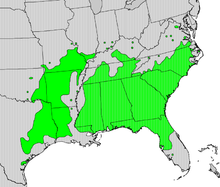| Vaccinium arboreum | |
|---|---|

| |
| Scientific classification | |
| Kingdom: | Plantae |
| Clade: | Tracheophytes |
| Clade: | Angiosperms |
| Clade: | Eudicots |
| Clade: | Asterids |
| Order: | Ericales |
| Family: | Ericaceae |
| Genus: | Vaccinium |
| Species: | V. arboreum
|
| Binomial name | |
| Vaccinium arboreum Marshall 1785
| |

| |
| Synonyms[3] | |
| |
Vaccinium arboreum (sparkleberry or farkleberry) is a species of Vaccinium native to the southeastern and south-central United States, from southern Virginia west to southeastern Nebraska, south to Florida and eastern Texas, and north to Illinois.[4][5]
Description
Vaccinium arboreum is a shrub (rarely a small tree) growing to 3–5 m (7.5-12.5 feet) rarely 9 m) (22.5 feet) tall, with a diameter at breast height of up to 35 cm (14 inches). The leaves are evergreen in the south of the range, but deciduous further north where winters are colder; they are oval-elliptic with an acute apex, 3–7 cm long and 2–4 cm broad, with a smooth or very finely toothed margin. Sparkleberry grows on sand dunes, hammocks, dry hillsides, meadows, and in rocky woods. It also grows on a variety of moist sites such as wet bottomlands and along creek banks.[6]
The flowers are white, bell-shaped, and 3–4 mm (0.12-0.16 inches) in diameter with a five-lobed corolla, produced in racemes up to 5 cm (2 inches) long. The fruit is a round dry berry about 6 mm (0.24 inches) in diameter, green at first, black when ripe, edible but bitter and tough.[6] They are eaten by various wildlife.[7]
Because of its relative hardiness in comparison to other Vaccinium species, Vaccinium arboreum has been investigated as a potential rootstock for expanding the range of blueberry cultivation to less acidic soils(PH>6.0) and reducing the severity of bacterial leaf scorch[8]
References
- ^ IUCN SSC Global Tree Specialist Group.; Botanic Gardens Conservation International; et al. (BGCI) (2020). "Vaccinium arboreum". IUCN Red List of Threatened Species. 2020: e.T152906341A152906343. doi:10.2305/IUCN.UK.2020-1.RLTS.T152906341A152906343.en. Retrieved 19 November 2021.
- ^ The Plant List, Vaccinium arboreum var. glaucescens (Greene) Sarg.
- ^ Tropicos, Vaccinium arboreum Marshall
- ^ USDA; Native Distribution - V. arboreum . accessed 11.10.2010
- ^ Biota of North America Program 2014 county distribution map
- ^ a b Flora of North America, Vaccinium arboreum Marshall, 1785. Farkleberry
- ^ Little, Elbert L. (1980). The Audubon Society Field Guide to North American Trees: Eastern Region. New York: Knopf. p. 629. ISBN 0-394-50760-6.
- ^ Darnell, Rebecca L.; Williamson, Jeffrey G.; Bayo, Deanna C.; Harmon, Philip F. (2020-01-01). "Impacts of Vaccinium arboreum Rootstocks on Vegetative Growth and Yield in Two Southern Highbush Blueberry Cultivars". HortScience. 55 (1): 40–45. doi:10.21273/HORTSCI14585-19. ISSN 0018-5345. S2CID 213728124.
External links
- "Vaccinium arboreum". Germplasm Resources Information Network. Agricultural Research Service, United States Department of Agriculture.
- Missouri Plants: Vaccinium arboreum
- Virginia Tech Dendrology: Vaccinium arboreum
- United States Department of Agriculture Plants Profile of Vaccinium arboreum

